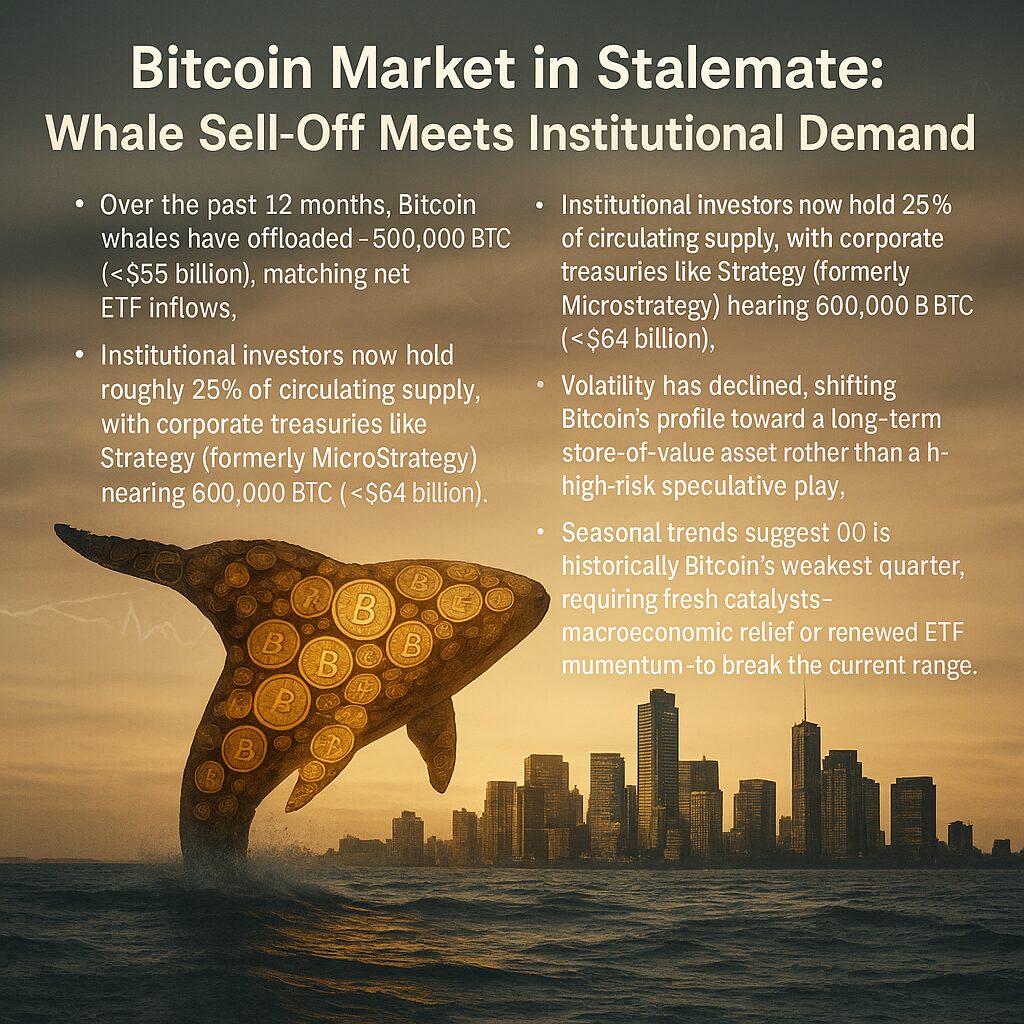
Main Points:
- Over the past 12 months, Bitcoin whales have offloaded ~500,000 BTC (≈ $55 billion), matching net ETF inflows.
- Institutional investors now hold roughly 25% of circulating supply, with corporate treasuries like Strategy (formerly MicroStrategy) nearing 600,000 BTC (≈ $64 billion).
- Volatility has declined, shifting Bitcoin’s profile toward a long-term store-of-value asset rather than a high-risk speculative play.
- Seasonal trends suggest Q3 is historically Bitcoin’s weakest quarter, requiring fresh catalysts—macroeconomic relief or renewed ETF momentum—to break the current range.
- On-chain data indicates dominant HODL behavior; profit-taking remains muted until price action exceeds $115–$120 k.
Whale Sell-Off vs. ETF Inflows
Throughout the past year, early Bitcoin adopters—commonly referred to as “whales”—have cumulatively sold over 500,000 BTC, equivalent to more than $55 billion at today’s prices. Bloomberg reports that this volume almost perfectly offsets net inflows into U.S. Bitcoin ETFs, leading to a supply-demand equilibrium that has capped price action near $110 k.
This tug-of-war between large-scale sell orders and ETF-driven buys has created a consolidation zone between $100 k and $112 k. Despite sporadic attempts to push higher, Bitcoin has lacked the volatility needed for a decisive breakout.
Institutional Accumulation and Corporate Treasuries
Institutional appetite for Bitcoin remains robust. Data show that institutions now hold about 25% of all circulating BTC, absorbing roughly 900,000 BTC through ETFs, corporate treasuries, and asset managers.
Among corporate holders, Strategy (formerly MicroStrategy) stands out. The company has amassed 597,325 BTC—just shy of the 600,000-BTC milestone—valued at over $64 billion based on an average acquisition cost of $70,982 per coin. In late June, Strategy purchased an additional 4,980 BTC for approximately $532 million, financed via at-the-market stock offerings.
These large treasuries serve dual purposes: they hedge corporate balance sheets against inflation and signal strong confidence in Bitcoin’s long-term store-of-value thesis. Inspired by Strategy’s playbook, a wave of London-listed smaller firms has followed suit, acquiring BTC to boost share valuations and investor interest.
Volatility Decline and Changing Risk Profile
On-chain and derivatives metrics indicate a marked decline in volatility. CryptoQuant, Glassnode, and Flowdesk reports all highlight “tight price action” and subdued trading activity, suggesting a shift from high-risk speculative trading toward long-term holding.
According to Glassnode data, investors sitting on unrealized gains averaging 125% have largely refrained from liquidating positions at current levels near $98,300–$110,000. This HODL-driven behavior underpins price support, reducing sharp drawdowns and smoothing out multi-week price swings.
Lower volatility draws parallel to gold’s market evolution: once viewed as a volatile curiosity, gold matured into a core component of institutional portfolios. Bitcoin appears to be undergoing a similar transformation—transitioning into a digital equivalent of a long-term “reserve asset.”
Seasonal Dynamics: Q3 Weakness Ahead
Historical patterns underscore that the third quarter (July–September) tends to be Bitcoin’s weakest period, with average returns of only +6%, compared to +27% in Q2. Bitfinex’s June Alpha report confirms that BTC has entered a range-bound consolidation between $100 k and $110 k, with spot volumes and open interest declining by 7.2%.
“Since May 8, BTC has been confined within $100 k–$110 k… Q3 has historically been its weakest quarter.”
— Bitfinex Alpha Report (June 30, 2025)
Without fresh catalysts—such as robust macroeconomic tailwinds or renewed ETF momentum—Bitcoin may remain confined to this corridor through the summer. Market participants will watch for U.S. inflation data, Fed policy signals, and potential ETF approvals to provide the next directional push.
Technical Perspectives and Price Targets
Analyst forecasts vary: some predict 10–20% annualized gains, capping BTC at around $120–$130 k, given the current supply-demand balance. Others, like Arthur Hayes, anticipate a cooling period until the Jackson Hole Symposium (Aug 21–23), with potential dips toward $90–$95 k if broader market sentiment sours.
Key technical levels to watch:
- Support: $100,000 (range floor)
- Resistance: $112,000–$115,000 (all-time high tests)
- Breakout trigger: Sustained ETF inflows > $2 billion monthly
- Catalysts: U.S. CPI/PPI prints, Fed commentary, ETF approvals/expansions
Figure 1: Bitcoin Volatility and Price Range
| Period | Volatility Index | Price Range (Low–High) |
|——————|——————|——————————|
| Q1 2025 | 75 | \$74k–\$112k |
| Q2 2025 | 60 | \$80k–\$111k |
| Early Q3 2025 | 50 | \$100k–\$110k |
Conclusion
The stalemate between whale sell-offs and institutional accumulation has ushered Bitcoin into a low-volatility, range-bound phase. While large holders continue to realize significant profits, robust ETF flows and corporate treasury buys provide consistent demand, holding the price near $110 k. On-chain analytics underscore a tide of HODL behaviors, suggesting that significant upside will require decisive catalysts—whether macroeconomic relief, regulatory clarity, or expanded ETF frameworks.
Investors seeking new crypto assets and revenue sources should monitor:
- ETF flow reports: Monthly net inflows > $2 billion could reignite uptrends.
- Institutional filings: Corporate treasury disclosures (e.g., SEC Forms 8-K).
- Macro data: U.S. inflation and Fed policy trajectory.
- On-chain signals: Liquidation clusters, HODL wave shifts, SOPR metrics.
As Bitcoin continues its evolution from a high-risk speculative instrument to a mature store-of-value asset, patient, long-term positioning may yield steady returns, with annualized gains of 10–20% achievable under current market conditions. However, traders should brace for seasonal Q3 headwinds and prepare strategies around confirmed breakouts beyond $115 k or breakdowns below $100 k.

